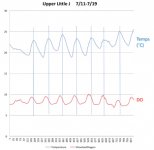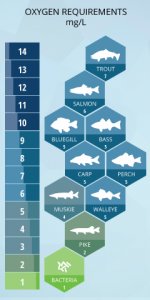nymphingmaniac
Well-known member
Some may find this surprising about DO versus stream temps. The biologists out there won't be surprised. I constructed a graph of temps versus DO on the upper J.
As you can see DO actually rises as temperatures are rising. The reason for this is the the uptick in temps is associated with the intensity of the sun on the river (correlates with time of day). The sun activate photosynthesis in the algae (and plants) in the stream bed, leading to a burst in release in O2. Once the temps peak and get high, then the amount of DO drops, probably because the output from microbes is over taken be the reduced physical properties of water to hold O2 and the activity of O2 consuming microbes.
This shows the complexity of a biological ecosystem and predictions based solely on the contributions of one element (temp vs DO) can be imprecise.
There are even some correlations with pH changes during the winter months with sunlight, DO and pH that are even more wild.
As you can see DO actually rises as temperatures are rising. The reason for this is the the uptick in temps is associated with the intensity of the sun on the river (correlates with time of day). The sun activate photosynthesis in the algae (and plants) in the stream bed, leading to a burst in release in O2. Once the temps peak and get high, then the amount of DO drops, probably because the output from microbes is over taken be the reduced physical properties of water to hold O2 and the activity of O2 consuming microbes.
This shows the complexity of a biological ecosystem and predictions based solely on the contributions of one element (temp vs DO) can be imprecise.
There are even some correlations with pH changes during the winter months with sunlight, DO and pH that are even more wild.






